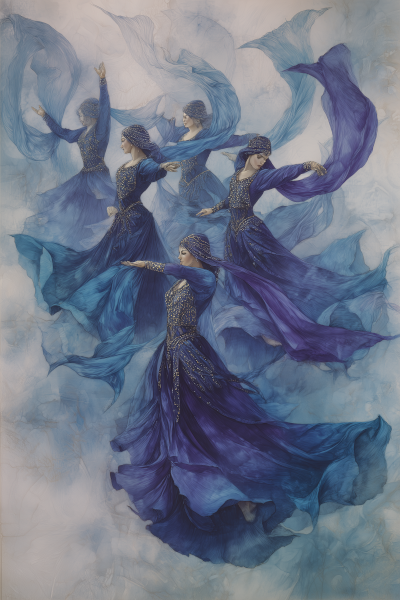Zahrat al-Sama (ZAH-rat al-sa-MAA)
Nahaya is at the heart of the Kalunat Ashtira festival, or so would say the dancers of Zahrat al-Sama (Flowers of the Sky). This sinuous, transcendent dance form has been part of the festivities for as long as this troupe of artists has been performing it. In fact the development of this devotional art and the history of the Zahrat al-Sama are inextricably intertwined.
Zahrat al-Sama began as a nameless troupe of four priestesses of Ashtira, the goddess of night, approximately two hundred years ago. Led by Lamia al-Ruhani, the women honed their moving meditations, rooted in folk rituals reaching back nearly to the time of The Shattering.
With time and effort, they molded it into a comprehensive and identifiable form of dance. Within fifty years, the style had a name, and so did the troupe, calling themselves "Flowers of the Sky." This is also the point at which Nahaya dances became part of the rituals and festivities for Ashtira's solstice festival.
Breath and improvisation form the twin hearts of Nahaya. Each dancer must be in tune with her own breath, yet also be aware of the movement and the subtle signals of the others. A good troupe will breathe in unison. Zahrat al-Sama moves like one organism.
The flowing costume of a Nahaya dancer, traditionally blue, deep purple, or silver, requires training to move in without tangling. So too, a dancer must learn to use the tools of the dance as an extension of herself. Traditionally this means diaphonous veils or scarves, and colorful ribbons. Depending on the festival, she may also need small mirrors, a lantern, or even fans. However, a dancer in the Zahrat al-Sama will never use weapons in a dance, or even instruments. The dance is her offering to Ashtira.
Dancing with the Zahrat al-Sama is not easy. The high-prestige troupe only keeps a maximum of ten principal dancers, as well as several alternates. Young women will train for years at noted school Bayt Zahriya just to get an opportunity to audition, but a spot is not guaranteed to even open up.
Once membership has been achieved, a dancer can be expected to train up to six hours a day, including essential breath practice. This does not, however, include her personal devotions and meditations, which can total an additional hour, at least. The performance schedule is demanding, as well, involving a number of religious festivals, plus royal ceremonies and official temple functions.
While Zahrat al-Sama still maintains close ties with the Temple of al-Ashtira, they are no longer solely a troupe of priestesses. A century ago, they opened their doors to a wide array of dancers, just as Nahaya itself was branching out in to multiple forms. By then, their performances had become an integral part of the large Kalunet Ashtira festival in Telkara.
Roughly fifty years ago a turning point was reached. For the first time, the troupe was invited to perform at stages around the city, not just at the temple district. Within a few years, other troupes were clamoring to perform as well. The Amir of Telkara decreed that any troupe wishing to perform at the festival must audition for the town, with the notable exception of Zahrat al-Sama.
Today that decree still holds, and the primary stage is always theirs. Other up and coming groups, like the Lahn al-Rih (Melody of the Wind) troupe, seek to challenge this supremacy, but for now, Zahrat al-Sama are the face of Nahaya.

Founding
193 AS
Overall training Level
Elite
Assumed Veterancy
Experienced



Thanks so much for entering the Formation Known for its Adaptability category this Summer Camp! Interesting article. Neat layout as well. God bless and much success to you with the rest of your plans for this year! <3
Check the latest in the wonderful world of WILLOWISP...
Find out what I'm up to...
Support my creative efforts <3